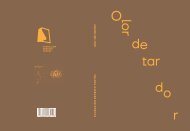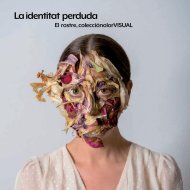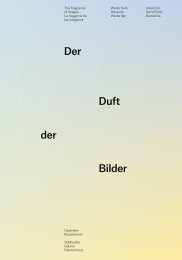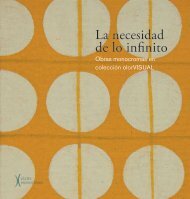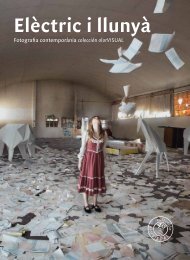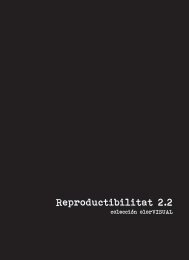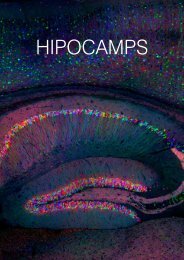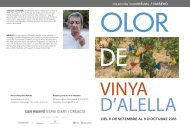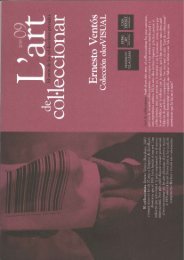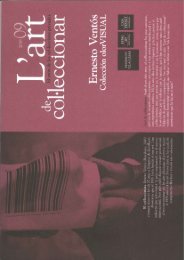Create successful ePaper yourself
Turn your PDF publications into a flip-book with our unique Google optimized e-Paper software.
These are artists who examine the timeless, the invisible. In many of them,<br />
just as in Monet’s works, the image emerges from the background. Light<br />
constructs and dematerialises at the same time. Reality seems alien, as in<br />
the video by Tim White-Sobieski, a New York-based artist with Polish roots<br />
who explores the painterly possibilities of the moving image by examining<br />
the advances in visual representation. Shapes tend to blur in the rhythmic<br />
succession of images which accompany a sound piece that provides the<br />
rhythm. In the video, images and scents act as resonances or vibrations of<br />
different realities that we find in the air and water. It is not too far from what<br />
Juan Uslé’s painting reflects. With photography almost always present in his<br />
process of visual construction, either as an invisible support or as an explicit<br />
technique in recent years, Juan Uslé works with painting as a means of<br />
representing the intellectual and vital record of reality. In the text written for<br />
the work Bonues Words, he tells how he left the yard and headed to the pool,<br />
and how the liquid became denser and harder to go through. That seems like<br />
a fantastic metaphor not only for the pictorial, but also for the dream and that<br />
relationship with water that Bachelard described so well. It is the energy that<br />
condenses and yet displaces the referents; dynamism. Uslé, who examines<br />
like no one else the dialogue between the frantic pace of reality and the ‘self ’<br />
which is diluted in vision, constructs a painting that is articulated in open series<br />
which outline a discontinuous, fluid process, always based on saturation and<br />
transparency, as well as an almost manneristic passion for gesture which harks<br />
back to the expressionist roots of his painting. His is a painting of contrasts,<br />
from the most fragile to the most robust, from light to thick, from the speed<br />
of some brushstrokes to the slowness of others that betray a tense look at the<br />
painting. Thus, each painting is a kind of pictorial threshold that contains an<br />
unreachable message, a place of inwardness which in the light is the key figure<br />
to generate that state of transition, that painting in the guise of an event,<br />
similar to what we feel when we watch the video by Tim White-Sobieski or<br />
gaze upon the wonderful garden painted by Albert Oehlen. In the latter, we<br />
get the same feeling as in Monet of the absence of the horizontal line, as if<br />
we were literally in the garden or the pond, permeated with its scent. Oehlen’s<br />
painting is a dance that is simultaneously convulsive and gentle, labyrinthine<br />
like the perfumed, primeval garden of Antonio Saura.<br />
These works are inspired by nature and assume both the specific and the local, like<br />
the works by Fernando García and Mayte Vieta. The silence of dead flowers bursting<br />
with colour is what joins them with other still lifes, like the ones by Nuria Fuster and<br />
Jannis Kounellis. Before them we feel outside time, and silence is contained as matter,<br />
which takes on a radical presence. In all of them there is a respect for composition<br />
and its traditions. A pictorial space takes shape, and materiality and its relationship<br />
with architecture tauten, the space is planned and formalised through the objects.<br />
The scent of colours appears on the threshold on the unspeakable. It<br />
does so suddenly, as if it was violating the border of the impossible without<br />
manipulating the matter, but instead letting it manifest itself. The temptation<br />
of silence does not prevent space from being set to music, as happens in the<br />
geometric burlap by Mark Hagen, which smells of earth and wood. Or the<br />
poetic thread in the ambiguous painting by Richard Aldrich. The paint vanishes<br />
like a smell, like colour, like Víctor Pimstein’s image about to be extinguished.<br />
Painting, and sculpture, are an exercise of emptying, as if the goal were to find<br />
the essential scent. We can see this in the box by Txomin Badiola, as well as in<br />
the trembling painting by Jürgen Partenheimer, where colour produces a given<br />
effect depending on its formal organisation and each individual’s psychology. But<br />
if colour is important in Partenheimer’s works, so is drawing, or more accurately<br />
136




